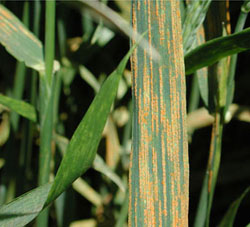Mild Winter Means Earlier Scouting
Mild Winter Means Earlier Scouting

Even though it’s the middle of winter, there haven’t been many days that have felt like winter in Kentucky. While there’s still a lot of winter ahead, the chances of it being a mild one seem to be increasing.
According to Tom Priddy, University of Kentucky College of Agriculture meteorologist, a moderate La Niña in the equatorial Pacific is causing the medium- and long-range weather outlooks to show above normal temperatures and above normal rainfall for Kentucky and the rest of the Ohio Valley.
If the winter continues to be mild, wheat producers may want to monitor their fields for the presence of two late-season diseases earlier than they normally would in the growing season, said Don Hershman, UK extension plant pathologist.
Leaf and stripe rusts tend to overwinter in wheat in states farther south like Louisiana and Texas, because the rust fungi can only survive in living leaf tissue and are killed by extended periods of freezing temperatures. Thus, in most years in Kentucky, rusts that take hold in wheat seedlings in the fall die during the winter due to the combination of freezing temperatures and lack of insulating snow cover. Rusts that overwinter in the Deep South have to build up and blow northward, which means they typically arrive in Kentucky too late in the season to cause significant yield losses. However, the risk that either or both diseases will develop earlier in the spring and increase to damaging levels at critical wheat growth stages increases during mild winters due to the possibility that one or both rust fungi might have overwintered at higher than normal levels.
“It is not highly unusual for low levels of leaf and stripe rust to overwinter in Kentucky, however, the mild fall and winter we have experienced, thus far, suggests that we could see rusts occurring earlier and building to damaging levels in susceptible wheat varieties this spring due to increased winter survival,” Hershman said.
Phil Needham, with Needham Ag Technologies, regularly scouts fields for producers in Kentucky and other states. He said he hasn’t seen any stripe or leaf rust in Kentucky fields yet, but that doesn’t necessarily mean these diseases won’t appear this year.
“We had some stripe rust last year in susceptible varieties; so with the mild winter, we expect to see some again this spring,” he said. “Leaf rust also occurs most years.”
Hershman added that because all varieties have different levels of susceptibility to leaf and stripe rusts, if the diseases do overwinter in significant enough levels, each field will have its own disease potential.